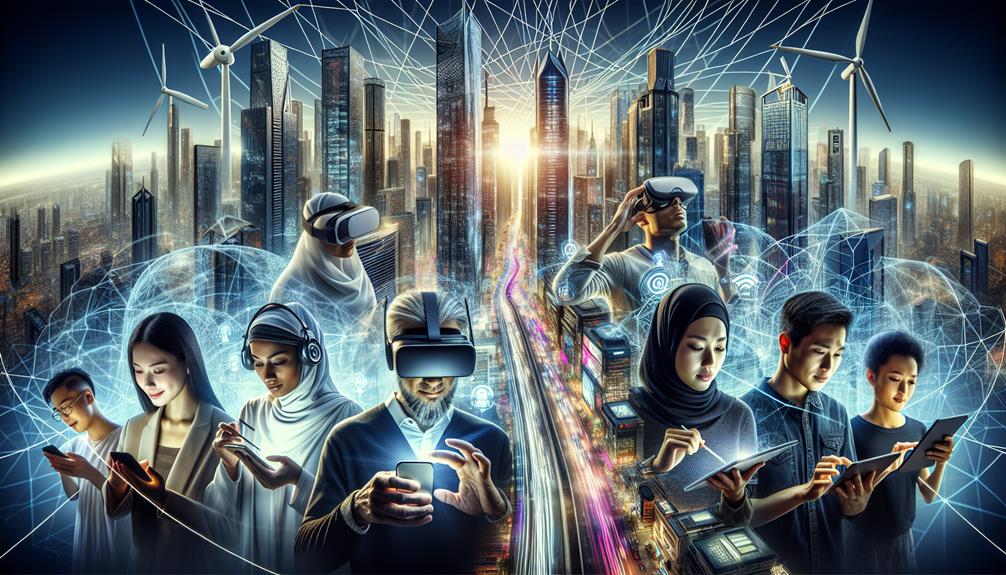Imagine living in a world where your smartphone connects to the internet at speeds that make today’s technology look like ancient history. That’s the promise of 5G technology, which you’re about to experience. This new era of connectivity not only boosts your download and upload speeds but also drastically reduces latency, making your online interactions almost instantaneous. You’ll find that everything from streaming ultra-high-definition videos to engaging in real-time gaming becomes seamless. But how exactly does 5G manage to achieve this feat, and what implications might it have for the future of digital communication? Let’s explore what sets 5G apart from its predecessors and why it’s critical for the evolution of connected technologies.
5G Technology
The evolution of mobile networks represents a monumental shift in communication technology, culminating in the advanced capabilities of 5G. This cutting-edge technology is characterized by not only dramatically increased speeds and reduced latency, but also its ability to support an unprecedented number of connected devices, heralding a new era of connectivity.
5G technology is set to transform industries and daily life, with applications ranging from autonomous vehicles to smart cities and beyond. According to a report by the Global System for Mobile Communications (GSMA), 5G networks are expected to cover one-third of the world’s population by 2025, indicating its rapid expansion and potential impact.
In analyzing the transformations brought about by 5G, it becomes evident that this technology is not merely an upgrade but a pivotal development in mobile communications, enabling real-time data transfer and connectivity that was previously unimaginable.
Evolution of Mobile Networks
To appreciate the significance of 5G, it is crucial to understand the transformative journey from 1G to 5G, with each generation marking substantial advancements in technology.
The journey began with 1G, which allowed for basic analog voice communication. As we progressed to 2G, digital voice and SMS were introduced, fundamentally changing how users interacted. With the advent of 3G, mobile data and internet access became mainstream, paving the way for 4G, which further elevated mobile web capabilities and data rates.
5G represents not just an incremental upgrade but a quantum leap in mobile communications. For instance, in a recent case study conducted in South Korea, the deployment of 5G has enabled ultra-high-definition (UHD) broadcasting and real-time remote surgeries, showcasing the technology’s potential to revolutionize healthcare.
From 1G to 5G
The progression from 1G to 5G illustrates a remarkable evolution in communication technology, emphasizing significant enhancements in speed, capacity, and connectivity.
- 1G: Analog voice communication.
- 2G: Digital voice and SMS.
- 3G: High-speed mobile data and internet access.
- 4G: High-definition mobile web, increased data rates.
- 5G: Ultra-high speeds, low latency, and the ability to connect millions of devices simultaneously.
Each generation has not only improved existing capabilities but has also expanded the landscape of mobile connectivity, resulting in transformative applications across various sectors.
Key Features of 5G
Exploring the key features of 5G technology reveals its potential to revolutionize connectivity through ultra-high speeds and low latency, which are critical for modern applications.
5G networks are designed to deliver download speeds of up to 10 gigabits per second, which is up to 100 times faster than 4G. This dramatic increase means users can download high-definition movies in seconds, fundamentally changing the entertainment landscape.
Moreover, 5G’s low latency—often as minimal as one millisecond—enables seamless interactions with real-time applications, such as augmented reality (AR) and virtual reality (VR). For example, Verizon’s 5G network has been implemented to enhance gaming experiences, providing instantaneous response times that are crucial for competitive gaming.
Ultra-High Speeds and Low Latency
5G technology revolutionizes connectivity by delivering ultra-high speeds and remarkably low latency, significantly enhancing digital interactions.
Here’s how 5G impacts everyday life:
- Download Speeds: Experience speeds up to 10 Gbps, allowing for lightning-fast downloads of high-definition content.
- Latency: A reduction to as little as 1 millisecond, which is essential for real-time applications like remote surgery and autonomous driving.
- Capacity: 5G can support up to one million devices per square kilometer, vital for the Internet of Things (IoT).
- Reliability: The technology provides more consistent and stable connections, crucial for mission-critical applications.
Experts predict that as 5G becomes more widespread, it will enable innovations that were previously limited by network capabilities. As we move forward, the integration of 5G in various sectors will undoubtedly reshape our digital landscape.
Applications of 5G Technology
You’ll find that 5G technology greatly enhances mobile internet speeds and capacity with Enhanced Mobile Broadband (eMBB), catering to your need for high-data-rate applications and immersive experiences.
Additionally, with Massive Machine-Type Communications (mMTC), 5G supports an extensive network of IoT devices, streamlining everything from urban infrastructure management to industrial automation.
These applications not only promise enhanced efficiency but also pave the way for innovative practices across various sectors.
Enhanced Mobile Broadband (eMBB)
You’ll find that Enhanced Mobile Broadband (eMBB) under 5G technology fundamentally transforms your streaming experience.
With notably higher data rates and reduced latency, you can access high-definition video services with unprecedented speed and efficiency.
This leap in capability supports richer and more immersive multimedia content, directly impacting how you consume digital entertainment.
Revolutionizing Streaming Services
As streaming services evolve, enhanced mobile broadband (eMBB) under 5G technology greatly improves your video streaming experience by providing unprecedented data speeds and reduced latency. Here’s how:
- Higher Resolution: Stream 4K and 8K without buffering.
- Simultaneous Connections: Multiple devices can stream high-quality content concurrently.
- Interactive Features: Real-time interactivity with minimal delay.
- Enhanced Accessibility: Reliable streaming on the move, even in crowded areas.
Massive Machine-Type Communications (mMTC)
Massive Machine-Type Communications (mMTC) empowers 5G networks to connect a vast number of devices simultaneously, enhancing efficiency in industries like manufacturing and utilities. You’ll find that mMTC is pivotal in scenarios where communication requirements involve high device density rather than high data rates.
For example, in smart cities, mMTC enables thousands of sensors to operate interdependently, managing traffic flow or monitoring environmental conditions with minimal human intervention.
This technology is designed to handle extensive connections through small, intermittent transmissions, which are typical in industrial IoT environments. As you explore further, you’ll appreciate how mMTC’s capability to support up to one million devices per square kilometer revolutionizes the scalability of networks.
This density is critical in applications like asset tracking and management in logistics, where potentially thousands of items equipped with sensors require simultaneous connectivity without draining the network.
Furthermore, the low power requirement of mMTC devices ensures long battery life, which is important for deployments in remote or hard-to-reach areas. This aspect is particularly beneficial for agricultural technology, where sensors monitor soil moisture and crop health over vast areas.
Challenges and Opportunities in 5G Research
As you delve into the world of 5G technology, you must consider the notable security challenges it presents. These concerns primarily stem from the increased complexity and the vast number of devices connected to 5G networks.
Additionally, you’ll need to navigate the complex regulatory landscape that governs 5G deployment, which varies considerably across different jurisdictions.
Security Concerns in 5G Networks
As you explore the evolving 5G landscape, it’s essential to address the increasing sophistication of cyber threats targeting its infrastructure.
Effective strategies must be implemented to detect and neutralize these risks, ensuring robust protection across the network.
This involves not only enhancing encryption methods but also continuously updating and adapting security protocols to outpace potential vulnerabilities.
Mitigating Cyber Threats in 5G Infrastructure
Understanding how to effectively mitigate cyber threats within 5G infrastructure is critical for ensuring network security and reliability.
Here’s what you need to focus on:
- Implementing advanced encryption protocols to secure data transmission.
- Utilizing AI-driven anomaly detection systems to identify and neutralize threats in real-time.
- Establishing robust access control measures to prevent unauthorized network access.
- Conducting regular security audits and compliance checks to maintain security standards.
Regulatory Implications of 5G Deployment
Regulatory frameworks greatly influence the deployment of 5G technology, presenting both challenges and opportunities for research and development. As you navigate these regulations, you’ll find that they dictate not only the pace but also the scope of 5G implementation. These frameworks are crucial in guaranteeing that 5G deployments meet safety, privacy, and environmental standards. However, they can also pose notable barriers, slowing down the rollout of new technologies and the testing of innovative applications.
You must understand that each country’s regulatory body has its own set of rules, which can vary considerably. This variation often complicates your efforts to launch unified global 5G services. Additionally, the high frequency bands used in 5G require more base stations to ensure widespread coverage and service reliability, leading to more intricate compliance issues with local zoning laws and electromagnetic field standards.
On the flip side, these regulatory challenges spur you to innovate more robust solutions. They push you to develop advanced technologies that comply with strict regulations while maintaining high performance. This necessity drives forward research in electromagnetic field safety, energy efficiency, and secure network architectures, offering you the opportunity to lead in high-standard 5G deployment.
Future of 5G Technology
As you explore the future of 5G technology, you’ll find that advancements aren’t only refining existing frameworks but also setting the stage for post-5G innovations.
The integration of 5G into IoT and smart cities illustrates a pivotal shift, enhancing how urban environments are managed and experienced.
These developments promise to redefine connectivity standards, offering unprecedented speed and reliability that could transform daily operations and service delivery.
Advancements Beyond 5G
As you explore the future of 5G technology, you’ll find that advancements such as 6G are on the horizon. These next-generation technologies promise markedly higher speeds, lower latency, and greater capacity than 5G.
Understanding these progressions is vital for anticipating how they might revolutionize connectivity in various industries.
Exploring 6G and Beyond
Exploring 6G and beyond, researchers are paving the way for advancements that promise even greater speeds and more reliable connectivity than 5G.
- Terahertz Frequencies: Enables ultra-fast data transmission rates surpassing 1 terabit per second.
- Advanced Antenna Technologies: Enhances signal directivity and range.
- Sophisticated Network Slicing: Optimizes resource allocation dynamically.
- AI-Integrated Networks: Facilitates predictive maintenance and autonomous network optimization.
Impact of 5G on IoT and Smart Cities
While 5G technology enhances connectivity speeds, its real value lies in revolutionizing the Internet of Things (IoT) and the development of smart cities by enabling more efficient, real-time data processing and exchange.
The deployment of 5G creates a robust infrastructure that supports the vast number of devices connected within IoT ecosystems. You’ll experience a dramatic increase in the number of devices that can be managed simultaneously, reducing latency to nearly zero. This is critical for applications requiring instant response and data analysis, such as autonomous vehicles and real-time remote medical monitoring.
5G’s capability to handle massive data throughput and reduce latency transforms how smart cities operate. It allows for real-time management of city infrastructure, from traffic control to energy distribution, enhancing efficiency and sustainability.
You’ll see a shift toward more dynamic and responsive city services, which adapt to real-time conditions and data inputs. For instance, traffic lights can adjust in real-time to traffic flow conditions, notably reducing congestion and emissions.
Moreover, enhanced security protocols in 5G networks ensure that the increased connectivity and data exchanges within these smart environments are secure from cyber threats. This is paramount as the number of connected devices and the volume of data they generate and share expand exponentially.




